There are six types of aquarium corals commonly kept in a saltwater tank. They are:
- SPS Corals
- Soft Corals
- LPS Corals
- Zoanthids
- Mushrooms
- Gorgonians
1) SPS Corals (Small Polyp Stony)
Small polyp stony (SPS) corals are characterized by their stony skeleton, made of calcium carbonate, and, as their name implies, smaller polyps. They are considered reef builders on a natural coral reef because they pull calcium from the water and turn it into the stony structure that comprises their skeletons.
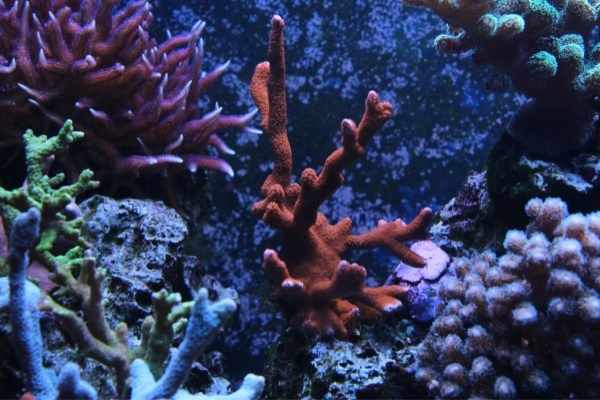
SPS corals are considered one of the most demanding groups to care for, requiring more precision with water parameters, feeding/nutrition, and more demanding light and water flow needs. But, generally speaking, many saltwater aquarium owners work their way up to keeping the ‘sticks’ in their tanks.
Learn more about the Small Polyp Stony Corals here.
2) Soft Corals
Soft corals, by comparison, lack a proper stony calcium carbonate skeleton. Instead of a bony skeleton, they have tiny slivers of a skeletal structure called sclerites, smaller pieces of stony structure about the size of fingernail clippings. The sclerites are embedded into the tissue of the soft corals and are one of the things that can be used to properly distinguish between certain closely related species.
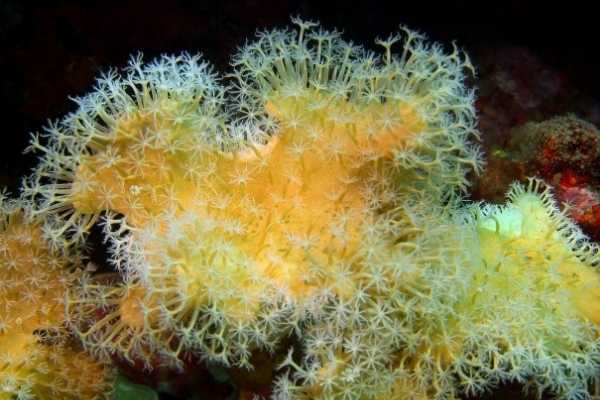
Many saltwater aquarium owners will start off with softies as the first aquarium corals they care for. Many of the most common and hardy are suitable for all experience levels. But not all soft corals are for beginners–many of the most beautiful and delicate softies, like the non-photosynthetic Carnations and related species, top the charts in terms of beauty and difficulty in caring for.
Learn more about the Soft corals here.
3) LPS Corals (Large Polyp Stony)
If you were to try to create a new aquarium coral species that combined the soft fleshy polyps of the prototypical soft corals with the stony calcium carbonate skeleton present in SPS corals, you’d probably create something that looked a lot like a Large Polyp Stony (LPS) coral.
These corals are fantastically popular in the hobby, perhaps because they bring the best of both worlds–a rhythmic swaying of fleshy polyps in the underwater currents along with the building of calcium carbonate skeletons.
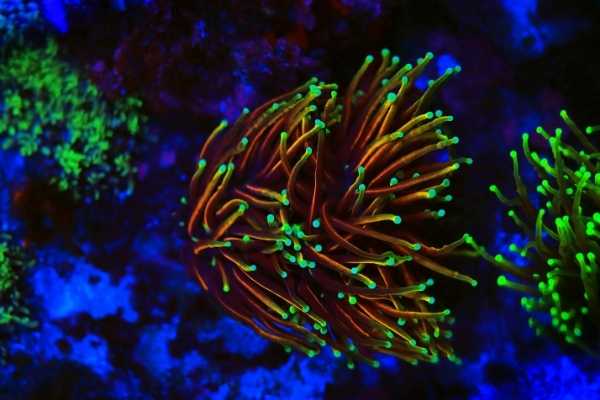
There are a few different growth forms, including massive, like the Favia species, single-polyped, like Scolymia, there are even multiple growth forms within a single species–like the Euphyllia species that are seen in both walled and branching varieties.
Learn more about the Large Polyp Stony Corals here.
or
Jump right in and pick one of the 14 Best LPS corals for beginners in this article.
4) Zoanthids
Zoanthids are a large and diverse category of aquarium corals that display a dizzying array of psychedelic colors. There are three main growth forms and four genera, commonly found in the aquarium hobby.
The growth forms are:
- Each polyp is completely individual and not connected to its neighboring polyps directly.
- Loosely connected by a thin layer of tissue at the bottom of the polyps
- Tightly connected by a thick mat or stolen

The genera are:
- Palythoa
- Parazoanthus
- Protopalythoa
- Zoanthus
Because there are so many different highly desirable color morphs, hobbyists refer to each of the morphs with fancy marketing names, like whammin’ watermelon, purple people eaters, or fruit loops.
Learn more about the Zoanthids here.
A lot of aquarium owners like to keep a group of different colored zoanthids and create a display better known as a zoanthid garden. You can learn more about those here.
5) Mushrooms (Corallimorphs)
Unlike some of the other aquarium corals on this page, mushroom corals don’t have any stony, calcium carbonate-based skeletal components. Instead, they have large, disc-shaped individual polyps.
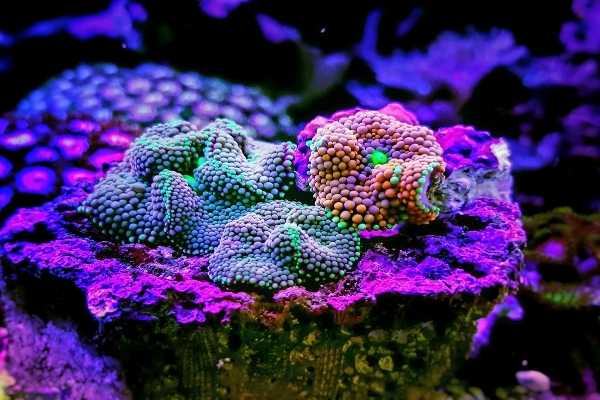
For years, they were thought of as some of the easiest (and sometimes least interesting) corals to add to an aquarium. Still, they have experienced a renaissance, of sorts, over recent years, with electric and vibrant morphs recapturing the attention of aquarium owners of all levels of experience.
Learn more about the Mushroom Corralimorphs here.
6) Gorgonians
Gorgonians are a category-busting group of aquarium corals. The polyps are protected by a semi-rigid, tough, leathery shell that allows them to gently flow in the current. The group contains some species that are quite suited to aquarium life and others with a dismal track record in captivity.

Learn more about the Gorgonians here.
Coral reproduction
Corals are fascinating organisms for many reasons, but one of my absolute favorite coral facts is that they can reproduce both sexually and asexually. Asexual reproduction of corals is typically called “fragging” because almost every fragment containing polyps, or even pieces of a polyp that is broken off from a colony of coral can grow into a full-sized adult colony that is genetically identical to the parent.
Fragging corals
This remarkable adaptation and survival strategy has spawned (pun intended) an entire industry of fragging and aquaculture.
There are two great ways for you to learn more about how to frag corals growing in your aquarium. First, this topic is explored in detail on this website. Check out this article:
Getting started fragging corals.
Or pick up a copy of the book, How to Frag Corals, available on Amazon.com and other retailers.
Spawning
Due to advancements in our aquarium equipment and life support systems and our understanding of what it truly takes to care for aquarium corals, there are also reports of coral spawning. This occurs when coral polyps release eggs and sperm into the water column, resulting in massive numbers of fertilized eggs and embryos, which can then settle and grow. It is still relatively rare to observe this in an aquarium setting, although I fully expect this to be an increasingly common occurrence over the next several years.
Corals for beginners
The ideal aquarium corals for beginners will be generally hardy and tolerant of the type of water conditions one would expect from a beginner saltwater tank. They should also be able to grow under different lighting conditions and not require much supplementation or feeding.
Two of the 5 best beginner corals are:
- Green star polyps –Pachyclavularia violacea
- Kenya tree corals – Cladiella spp.
These corals will grow quite rapidly and spread in all but the most sterile aquarium conditions, making them ideal for beginners.
To see the rest of the list and learn more, here is a great article highlighting a few of the best corals for beginners.
Corals for low light
Most of us think about aquarium corals as animals that derive a substantial amount of their nutritional needs from the reef lights we hang above our tanks. But there are also many different species of corals that are ideally suited for low light environments. Some are great for beginners who haven’t invested in an expensive light fixture, and others are great for those darker regions of the tank because they either don’t need a lot of light or are not photosynthetic.
Two of the 11 best corals for low light are:
- Mushroom corals
- Toadstool corals
To learn more about these aquarium corals, as well as the other 9 of the 11 best low light corals, check out this article here.
Coral for fish tank
If you already have a saltwater fish tank (sometimes called a fish-only tank, which means you have only fish and don’t have corals or other invertebrates in the aquarium), you may be wondering which corals are best for adding to a fish tank.
My recommendation would be to start off with hardy and tolerant species, like Xenia, Toadstools, Kenya tree, Mushrooms or Cabbage corals as first corals for a fish tank, before branching out (pun intended) to some of the other branchings LPS corals, like Trumpet or Candy cane, Torch, Hammer, and Frogspawn corals.

All of the above species are relatively hardy and tolerant of the nutrient-rich waters found in a saltwater fish tank. They also don’t generally require the most intense lighting regimens, making a great early choice for a tank build that includes saltwater fish.
Feeding corals and coral food
Feeding the aquarium corals in a saltwater tank is important to their overall health and growth. Growth requires energy. Energy comes from nutrition.
Many corals indeed have a symbiotic relationship with single-celled photosynthetic organisms called zooxanthellae, which share some of the bounties from their photosynthesis–sugar–with their coral hosts. Still, there is a lot more to coral feeding and nutrition than just photosynthesis.
Many aquarium coral species will absorb amino acids and other nutrients directly from the water column. However, some require phytoplankton, and 0thers benefit from a direct feeding of right-sized foods captured by the feeding polyps.

Julian’s thing and the Sea Squirt are two tools popular among aquarium coral owners to help target-feed their invertebrates.
Target feeding is the process where you shut down your pumps, wait for the feeding polyps to emerge, and then gently squirt a food source onto the polyps.
Learn more about:
Best fish to keep with corals
If you plan to keep saltwater fish and aquarium corals together in the same reef tank, you want to look for the label or tag: reef safe. This generally means that the fish species in question does not eat coral polyps as part of its normal diet. But ‘not eating the coral’ is a meager hurdle and doesn’t mean that any fish that doesn’t eat corals is one of the best fish to keep with corals.
The best fish to keep with aquarium corals will not only not eat the corals, but they also won’t nip at, pick at or otherwise disturb them. They will also not be big messy eaters that leave much waste in the tank that could otherwise pollute and cause problems.
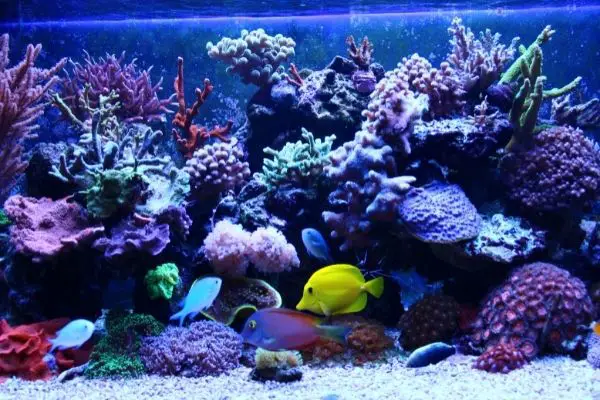
Here are a few articles to review to learn more about some of the best fish to keep with corals:
Ocellaris clownfish, royal gramma, pajama cardinalfish, green chromis, and many goby species are great companions for your corals. You can learn more about great saltwater fish species here.
Coral names and links to more information
There are a lot of great aquarium corals you could add to your saltwater aquarium. Check out the links below to learn more about each of the corals listed below.
Soft corals
Large polyp stony (LPS)
- Acan (Acanthastrea)
- Blastomussa
- Candy cane
- Chalice
- Duncan
- Elegance coral
- Favia
- Frogspawn
- Gonipora
- Hammer
- Lobophyllia
- Plate (fungia)
- Scolymia
- Sun
- Torch coral
- Trumpet
Small polyp stony (SPS)
- Acropora
- Bird’s nest
- Heliopora
- Montipora
- Pocillopora
- Pavona
- Plating corals
- Seriatopora
- Stylophora
- Staghorn